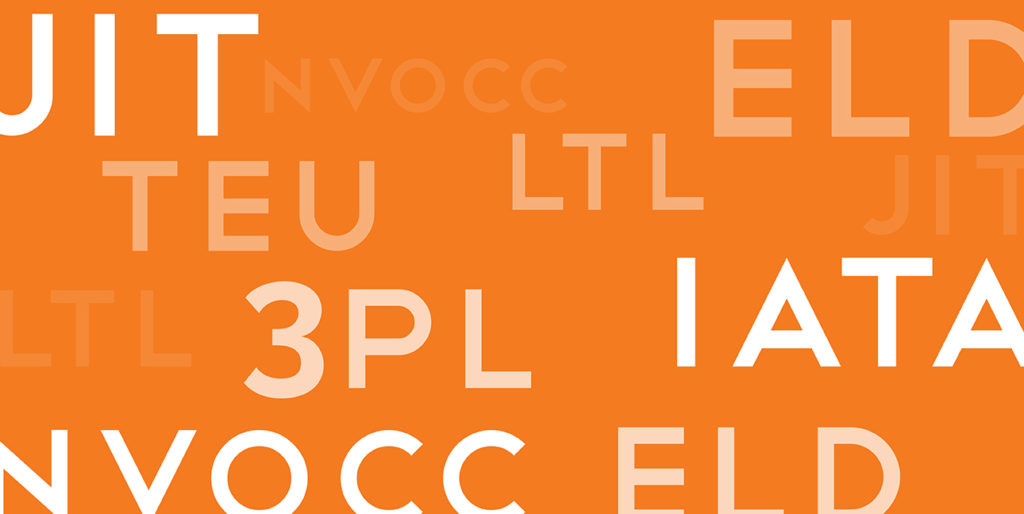Every industry has jargon that outsiders often don’t fully understand, and the logistics and supply chain management industry is no different. Often these commonly used, industry-related terms are shortened by using acronyms to save time. If you don’t know what the acronyms stand for, it will make navigating a conversation with seasoned industry experts quite difficult.
Our knowledgeable team has put together a helpful, short glossary with fifteen terms that we use day in and day out:
JIT – Just in Time:
JIT is an inventory management system that compares orders from suppliers with warehouse production schedules. This system allows warehouses to increase efficiency while also decreasing waste by only receiving goods as they are needed in the production process. This also cuts down on costs.
TEU – Twenty-foot Equivalent Unit
TEU is used to measure a ship’s cargo carrying capacity. The dimensions of one TEU are equal to a standard 20-foot shipping container: 20 feet long, 8 feet tall.
For example, the world’s largest container ships can carry in excess of 14,000 TEUs.
3PL – 3rd Party Logistics
As a 3PL provider ourselves, this term is something we use nearly every day. Third-party logistics refers to a company’s use of third-party entities to manage elements of their distribution, warehousing, and fulfillment needs. Although a third-party logistics provider does not hold ownership over the inventory they are managing, they are responsible for performing the requested fulfillment activities outlined by their clients.
Learn more about 3PLs in our recent blog.
LTL – Less Than Load
An LTL refers to “less than a truckload” shipment, meaning the transportation of small freight. Parcel carriers often handle these small freight shipments.
IATA – International Air Transport Association
IATA is the trade association for the world’s airlines and represents 82% of total air traffic. IATA works to ensure air space is safe and advocates for strong regulations of air travel.
ELD – Electronic Logging Device
ELD might be a more recognizable acronym since it is often associated with last year’s ELD Mandate update. ELD is technology that records drivers’ time and monitors their vehicles’ engines. The data collected from ELD allows for a better understanding of commercial driving habits and thus better regulatory policies can be made.
AI or ML – Artificial Intelligence or Machine Learning
Artificial intelligence is the development of computer system’s ability to perform tasks that normally only humans are able to do, like decision making and translation between languages. Machine learning is a study of algorithms and statistical models that computer systems use to improve performance on a specific task.
Learn more in our AI blog.
POE – Port of Entry
A POE is where shipments are allowed to enter after clearing customs. Typically in order to move through a POE efficiently, POE orders are used to ensure there is a record of the booking, shipping, and customs clearance.
NVOCC – Non Vessel Owning Common Carrier
A NVOCC operation often comprises of sales, packing, and transport of containers to ports. A NVOCC signs contracts with shipping lines to guarantee a set number of units every year and in return, the shipping line offers better return rates to the NVOCC.
We are proud to be licensed with the Federal Maritime Commission (FMC) as an NVOCC.
JOC – Journal of Commerce
The JOC is one of our favorite ways to keep up with current industry news and happenings. We also get the chance to share our expert insight with the JOC team on a regular basis.
TOC’s Solutions Director, Michael Klage, contributed to JOC’s recent article on Trans-pac contracts.
FF – Freight Forwarding
FF is the logistical challenge of coordinating and shipping goods from one destination to another using multiple carriers, such as air, ocean, rail, or highway.
FTZ – Foreign Trade Zone
An FTZ is a class of special economic zone where goods can be landed, stored, handled, manufactured, and even reconfigured and re-exported under certain customs regulations. We know this concept can be complicated, so reach out to our customs brokerage team with your questions on FTZs.
HVS – High Value Shipment
Both valuable cargo and special cargo fall into the category of “high value.” HVS can be quite expensive but are very important. If cargo is not handled with care or properly insured, the loss can be astronomical.
OEM – Original Equipment Manufacturer
An OEM is an organization that makes products from parts bought from other organizations. These products can be marketed by another organization after they are made.
And last but not least is our favorite logistics acronym: TOC. We named our company after our commitment to transparency, optimization, and collaboration.
For more information about TOC Logistics or our capabilities, please contact a member of our team today.

